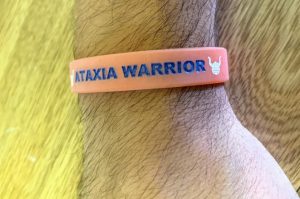I’m Learning to See Myself as an Ataxia Warrior

I’ve never thought of myself as especially strong, or as someone who could identify with a warrior’s personality. Because I face the progressively debilitating disorder Friedreich’s ataxia, I sadly realized that my physical strength, like the rest of my capabilities, will dwindle over time much more quickly than that of an average person.
I jealously watched as my friends ran marathons, played on softball teams, went on hikes, and did other activities. One even competed on the TV show “American Ninja Warrior.” When thinking of them, I laughed at the idea of calling myself a warrior.
But that began to change about two years ago, when a package arrived from my friend Ryan, who’d been recently diagnosed with an unknown form of ataxia. Ryan and his wife own a fitness center in Austin, Texas. He has received in the past a grant from the Ataxian Athlete Initiative, a program managed by the Friedreich’s Ataxia Research Alliance, which he used to purchase a recumbent trike. With the trike, he has joined many public rides since then to raise awareness about ataxia.
I opened the package he sent and found an orange bracelet. In bold blue text, it read “Ataxia Warrior.” I took it out of the box and put it on, and left it on for a long time. When I started wearing it, I soon began to suspect that the words could describe me, too.
I knew I couldn’t compete with my able-bodied friends, but I began to see the difference between a competitor and a warrior. When I compared myself to my able-bodied friends, I always felt lacking.
Instead of feeling sorry for my broken body, I started trying to live up to the wristband’s words. I decided to ride my recumbent trike every day that I could. I decided to maximize my effort at my weekly physical therapy appointments and then my personal training sessions.
Although I find physical activity often frustrating, until an approved treatment for Friedreich’s ataxia is developed, I believe that staying active is key to thriving in life with FA. I think that’s what an ataxia warrior would do.
At my physical therapy appointment last Thursday, I was trying to crawl in an upright position on the floor, which I’ve been practicing for months. I still haven’t mastered it, but trying to do it week after week exhausts me, and I love it.
As I was concentrating on trying to scoot a leg forward while keeping my balance on my hands and knees, I heard my physical therapist say, “Looks like your ‘Ataxia Warrior’ band finally gave out.”
We had talked about my wristband a lot — how I loved the idea of being an ataxia warrior, and how I hadn’t taken it off since I received it in the mail. It was a symbol that reminded me to never give up.
The ripped orange bracelet lay on the floor where my hand previously was. Before I grew sad that it tore, I grinned and said, “I’m happy it fell off here. It’s kind of fitting.”
The physical therapy clinic is where I push myself the hardest — more than I ever thought I could.
My physical therapist asked if I wanted to keep the wristband. I declined and told him to throw it away. He picked it up and walked toward the trash can by his desk.
I began to second-guess my decision. I really liked that wristband. Maybe I should keep it after all.
But it was too late to say anything.
“There,” he said, as I looked up. Rather than throwing it in the trash can, he had pinned the small orange band to the bulletin board in his office.
I’ve had to accept the fact that the word “warrior” doesn’t typically define me. I’m not an athletic warrior, and I’m definitely not an “American Ninja Warrior.” But as the torn wristband on the bulletin board reminds me: I am an ataxia warrior. And for now, that’s enough.
***
Friedreich’s Ataxia News is strictly a news and information website about the disease. It does not provide medical advice, diagnosis or treatment. This content is not intended to be a substitute for professional medical advice, diagnosis, or treatment. Always seek the advice of your physician or another qualified health provider with any questions you may have regarding a medical condition. Never disregard professional medical advice or delay in seeking it because of something you have read on this website.The opinions expressed in this column are not those of Friedreich’s Ataxia News or its parent company, Bionews, and are intended to spark discussion about issues pertaining to Friedreich’s ataxia.








Greg Klassen
Nice article! I have SCA3 (symptoms for 16 years) but am an active triker. I am thinking about doing the 2700 mile GDMBR as an ataxia awareness event. Do you have any interest?
Matthew Lafleur
Thanks for reading Greg! That rides sounds absolutely epic. Please give me more details because I would love to learn more about it but I am definitely not in the state to participate in a ride like that! I am satisfied for now with 10 miles! But maybe in the future!